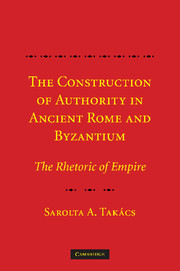Book contents
CHAPTER THREE - Appropriation of a Pattern
Published online by Cambridge University Press: 15 October 2009
Summary
Mending the Known World Order
The reign of Helvius Pertinax, Commodus's successor, was extremely short (January 1 to March 28, 193 CE). He was murdered by the praetorian guard when a dispute arose over Pertinax's inability to pay soldiers the promised donatives. There was simply not enough money left in the treasury. Contenders then arose on the periphery and, in 197 CE, Septimius Severus (r. 193–211 CE), governor of Pannonia superior (Eastern Austria and Western Hungary, 191–193 CE), emerged as the sole emperor. Although one of the contenders, Marcus Didius Julianus, had been legitimately appointed by the senate, Septimius Severus did not refer to Julianus as his immediate predecessor but Helvius Pertinax. Pertinax offered Septimius Severus a sound reputation based on glory and honor onto which the new ruler could graft his own virtuous actions. Pertinax had been a successful general under Marcus Aurelius and a man of excellent reputation among senators, and with a nudge from his self-proclaimed immediate successor, the senate deified him. As emperor and successor of a deified emperor, Septimius Severus was now notionally the son of a divine being, which further legitimized his position as the empire's new father. The dynastic lineage went back to Nerva, the adoptive father of Trajan.
After 18 years in power, Septimius Severus died in Eburacum (modern York) in 211 CE and left the empire to his two sons, Caracalla (r. 211–217 CE) and Geta (r. 211–212).
- Type
- Chapter
- Information
- The Construction of Authority in Ancient Rome and ByzantiumThe Rhetoric of Empire, pp. 81 - 118Publisher: Cambridge University PressPrint publication year: 2008



